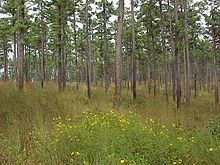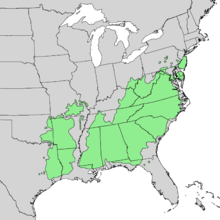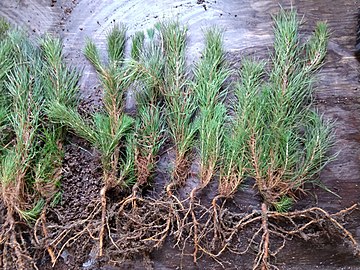
A pine is any conifer tree or shrub in the genus Pinus of the family Pinaceae. Pinus is the sole genus in the subfamily Pinoideae.

Pinus radiata, the Monterey pine, insignis pine or radiata pine, is a species of pine native to the Central Coast of California and Mexico. It is an evergreen conifer in the family Pinaceae.
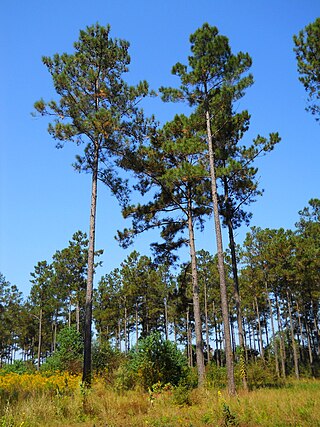
Pinus taeda, commonly known as loblolly pine, is one of several pines native to the Southeastern United States, from East Texas to Florida, and north to southern New Jersey. The wood industry classifies the species as a southern yellow pine. U.S. Forest Service surveys found that loblolly pine is the second-most common species of tree in the United States, after red maple. For its timber, the pine species is regarded as the most commercially important tree in the Southeastern U.S. The common name loblolly is given because the pine species is found mostly in lowlands and swampy areas.

The longleaf pine is a pine species native to the Southeastern United States, found along the coastal plain from East Texas to southern Virginia, extending into northern and central Florida. In this area it is also known as "yellow pine" or "long leaf yellow pine", although it is properly just one out of a number of species termed yellow pine. It reaches a height of 30–35 m (98–115 ft) and a diameter of 0.7 m (28 in). In the past, before extensive logging, they reportedly grew to 47 m (154 ft) with a diameter of 1.2 m (47 in). The tree is a cultural symbol of the Southern United States, being the official state tree of Alabama. This particular species is one of the eight pine tree species that falls under the "Pine" designation as the state tree of North Carolina.

Pinus jeffreyi, also known as Jeffrey pine, Jeffrey's pine, yellow pine and black pine, is a North American pine tree. It is mainly found in California, but also in the westernmost part of Nevada, southwestern Oregon, and northern Baja California. It is named in honor of its botanist documenter John Jeffrey.
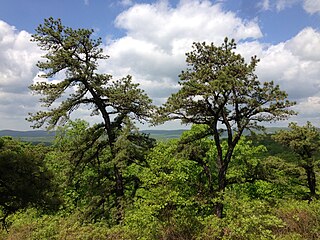
Pinus rigida, the pitch pine, is a small-to-medium-sized pine. It is native to eastern North America, primarily from central Maine south to Georgia and as far west as Kentucky. It is found in environments which other species would find unsuitable for growth, such as acidic, sandy, and low-nutrient soils.

Pinus serotina, the pond pine, black bark pine, bay pine,marsh pine, or pocosin pine, is a pine tree found along the Southeastern portion of the Atlantic coastal plain of the United States, from southern New Jersey south to Florida and west to southern Alabama. Pond pine distribution may be starting to spread west towards Mississippi and Tennessee.

Pinus elliottii, commonly known as slash pine, is a conifer tree native to the Southeastern United States. Slash pine is named after the "slashes" – swampy ground overgrown with trees and bushes – that constitute its habitat. Other common names include swamp pine, yellow slash pine, and southern Florida pine. Slash pine has two different varieties: P. e. var. elliottii and P. e. var. densa. Historically, slash pine has been an important economic timber for naval stores, turpentine, and resin. The wood of slash pine is known for its unusually high strength, especially for a pine. It exceeds many hardwoods and is even comparable to very dense woods such as black ironwood.
Yellow pine is a number of conifer species which yield similar strong wood.

Pinus pinaster, the maritime pine or cluster pine, is a pine native to the south Atlantic Europe region and parts of the western Mediterranean. It is a hard, fast growing pine bearing small seeds with large wings.

The Atlantic coastal pine barrens is a now rare temperate coniferous forest ecoregion of the Northeast United States distinguished by unique species and topographical features, generally nutrient-poor, often acidic soils and a pine tree distribution once controlled by frequent fires.
Resin acid refers to mixtures of several related carboxylic acids, primarily abietic acid, found in tree resins. Nearly all resin acids have the same basic skeleton: three fused rings having the empirical formula C19H29COOH. Resin acids are tacky, yellowish gums that are water-insoluble. They are used to produce soaps for diverse applications, but their use is being displaced increasingly by synthetic acids such as 2-ethylhexanoic acid or petroleum-derived naphthenic acids.
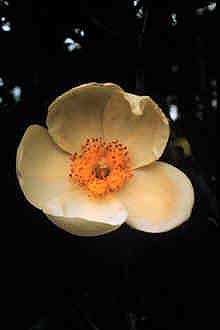
Gordonia lasianthus is a small to medium-sized evergreen tree or shrub found in acidic, swampy soils of pinelands and bays on the Atlantic and Gulf Coastal Plains of the southeastern United States. It is a member of the tea or family Theaceae. It is slow growing with soft, light-colored, fine-grained wood of little commercial value, although loblolly-bay could be managed as a source of pulpwood. When older specimens are cut, the wood exudes a strong scent. It is similar to a mixture of fresh oranges and pine sap. The bark of the adult tree varies from medium grey to a red brown coloration. Dead adult specimens of loblolly bay exhibit a lustrous shine when exposed to sunlight for several years. The white showy flowers and shiny foliage make it a desirable ornamental, but it is not easy to cultivate. Deer browse stump sprouts heavily.

Carya glabra, the pignut hickory, is a common, but not abundant species of hickory in the oak-hickory forest association in the Eastern United States and Canada. Other common names are pignut, sweet pignut, coast pignut hickory, smoothbark hickory, swamp hickory, and broom hickory. The pear-shaped nut ripens in September and October, has a sweet maple like smell, and is an important part of the diet of many wild animals. The wood is used for a variety of products, including fuel for home heating. Its leaves turn yellow in the Fall.

Carya tomentosa, commonly known as mockernut hickory, mockernut, white hickory, whiteheart hickory, hognut, bullnut, is a species of tree in the walnut family Juglandaceae. The most abundant of the hickories, and common in the eastern half of the United States, it is long lived, sometimes reaching the age of 500 years. A straight-growing hickory, a high percentage of its wood is used for products where strength, hardness, and flexibility are needed. The wood makes excellent fuel wood, as well. The leaves turn yellow in Autumn.

The Lost Pines Forest is a 13-mile (21 km) belt of loblolly pines in the U.S. state of Texas, near the town of Bastrop. The stand of pines is unique in Texas because it is a disjunct population of trees that is more than 100 miles (160 km) separated from, and yet closely genetically related to, the vast expanse of pine trees of the Piney Woods region that covers parts of Texas, Arkansas, Louisiana, and Oklahoma.

The Southeastern conifer forests are a temperate coniferous forest ecoregion of the southeastern United States. It is the largest conifer forest ecoregion east of the Mississippi River. It is also the southernmost instance of temperate coniferous forest within the Nearctic realm.
Bull pine is a common name for several species of North American “yellow pine” trees — Genus Pinus, Section Trifoliae — especially large, or unusually large and isolated, specimens of the following.
Both naturally and artificially occurring pine species (Pinus) can hybridize, combining their genetic material and sometimes creating hybrids that can be more or less vigorous than their parent species. An example of a naturally occurring hybrid pine is Pinus × sondereggeri, a naturally occurring cross between loblolly pine and longleaf pine. An example of the many artificial hybrids is Pinus lambertiana × P. armandii.

Harrison Experimental Forest is an experimental forest facility operated by the Southern Research Station (SRS) of the United States Forest Service in Harrison County, Mississippi. The experimental forest is located within the De Soto National Forest about 25 mi (40 km) north of Gulfport, Mississippi off Old Mississippi Highway 67.
